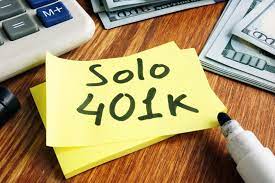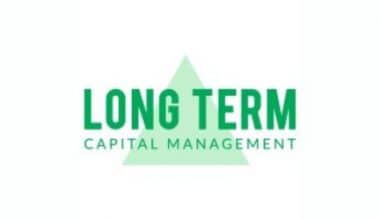Self-employment comes with a number of advantages, but there is at least one important disadvantage, and that is the absence of a retirement plan sponsored by an employer, such as a 401(k). Enter the solo 401(k), also known as a one-participant 401(k) according to the Internal Revenue Service (IRS). A solo 401(k) is a type of retirement plan that is designed for those who are self-employed and wants many of the benefits of an employer-sponsored plan but does not require them to work for someone else. Keep reading to understand the solo 401k contribution limits, vanguard, and the ROTH.
What Is Solo 401K?
A solo 401(k) plan, also known as a one-participant 401k or a solo K, provides an effective means of retirement savings for those who are self-employed. Owners of businesses with no employees (other than spouses) are eligible to join regardless of age or income level.
“The solo 401K has very high and flexible contribution limits, typically allowing more contributions than SEPs, traditional IRAs, Roth IRAs, or SIMPLEs,” explains Joe Conroy, CFP and proprietor of Harford Retirement Planners in Bel Air, Maryland.
However, when compared to other retirement plans for the self-employed, the solo 401(k) stands out since it allows employees to contribute 100% of their pay, up to the yearly maximum contribution. Unlike with certain other plans, they are not restricted to contributing a maximum of 25% of their earnings. This benefit can assist them reduce their tax burden, albeit it does not enable them to escape the self-employment tax.
In addition, if you’re familiar with how a regular or Roth 401k works, you’ll feel right at home with the solo 401(k). In the same way that you can contribute pre-tax dollars to a regular 401(k) and receive a tax advantage this year, you can do the same with your solo 401(k) if you set it up to accept tax-deductible contributions. Contributions to a Roth IRA are made after taxes are taken out, but withdrawals in retirement are free of taxation.
How to Set up a Solo 401K
The tax benefits of opening a single 401(k) account might be substantial if you meet the requirements. The contribution limits, tax deferral on investment growth, and the ability to invest in a wide variety of asset classes are all advantages of a solo 401k, which sets itself apart from other retirement plans.
Remember that the end of the 2022 tax year is the deadline for opening a solo 401(k) plan and making contributions for that year. In most cases, contributions for 2022 will be denied if the deadline is missed. You previously had until the company’s tax filing deadline to establish your solo 401(k) and make your elections, but this has been extended thanks to the new Secure Act 2.0, which was signed into law on December 30, 2022. Since the scheme wasn’t in place in 2022, employees can’t make deferrals and only the company can contribute to the profit-sharing pool.
The deadline to establish a single participant 401(k) and make election changes for the 2023 tax year is December 31, 2023. Now, let’s examine these sub-steps in detail.
#1. Choose a Carrier for Your Plan
The choices available from each solo 401(k) plan provider vary. The first order of business in setting up a solo 401k is to locate a plan provider that provides all of the features and benefits you’ll need.
The most crucial aspects of a solo 401(k) are:
- Roth option. One of the most significant tax benefits of a solo 401k account is access to the Roth IRA option. Even though your contributions are made with after-tax money, withdrawing from the account in retirement will cost you nothing in taxes. Typically, a Roth option is not included in institutional brokerages’ sample plans.
- Rollovers. Rolling over the maximum amount from another retirement plan into a solo 401(k) is permitted. This is the quickest and least complex method for starting a 401(k) for one. The best part is that it won’t count against your annual deductible.
- Investment platform. Although not widely available, certain plan providers, such as Ocho, provide an investment platform as part of their core offering. As a result, you won’t have to set up separate bank and brokerage accounts for your solo 401(k) trust or complete as many other preliminary processes.
- Administration help. Creating your account, maintaining it each year, and filing the necessary tax documents with the IRS. A plan provider can aid in the administration of the aforementioned tasks, among many more. Not all providers of solo 401(k) plans offer administrative assistance, but having access to such services can be extremely helpful.
In addition, you may trust the top solo 401k plan providers to help you through the remaining steps. If your plan’s administrator doesn’t give help with paperwork, move on to the next step.
#2. Obtain an EIN (Employer ID Number)
A company or trust can be identified by the Internal Revenue Service (IRS) with a special nine-digit number called an Employer Identification Number (EIN).
When starting a 401(k) plan on your own, you’ll need one of two EINs.
- A business EIN is required before you can apply for a solo 401(k) plan.
- A solo 401(k) plan automatically applies for its own EIN when it’s set up.
That is to say, in order to file for a solo 401(k), your organization can only have one EIN. Once you’ve set up your solo 401(k) trust, you’ll need to apply for a separate EIN. Your individual 401(k) trust owns all of the assets you put into it. They are not yours to use in any capacity. Because of this, the IRS requires a unique identifier for your solo 401(k) trust rather than using your name or the name of your business.
Business EIN applications and requirements
The vast majority of business owners will already have obtained an EIN. You can get an IRS identification number by applying for one online. It’s no cost, the application process takes only a few minutes, and in most cases, you’ll have your card immediately after submitting it.
#3. Prepare an Adoption Application and Contract
A significant amount of documentation is required to open a 401(k) plan for one person. The paperwork required to open a solo 401(k) is extensive and includes several distinct forms and forms. Although they are all required, the Plan Adoption Agreement and the Trust Agreement are the most critical to complete.
In order to apply for a plan with the vast majority of companies, you will need to read and sign numerous pages of paperwork. Some service providers may even need you to print out the application and mail it in. The Ocho Solo 401(k) plan, on the other hand, maybe set up and managed entirely in the digital realm in just ten minutes.
If your application for a single 401(k) is accepted, the next step is to open the account.
#4. Get a Tax ID Number for Your Solo 401(k) Trust
You’ll need to recall this from step 2.
You should apply for a trust EIN now that your single 401(k) has been approved. Also, you’ll follow the same steps that you did when you first registered your company. The only distinction is that rather than selecting “business,” you’ll select “retirement account trust” as the application type. Since we already did this in Step 2, this is the easy part. This is also taken care of if you use the Ocho Solo 401k.
#5. Get Your Solo 401(K) Trust Set Up With a Bank
With its own EIN, your single-person 401(k) trust can now set up financial transactions in its own name. You and your business are not part of your solo 401k trust. Your single 401(k) must be kept separate from your personal and professional finances. That would be a violation of the rules, for which there could be severe consequences.
Make sure you keep your solo 401k and solo Roth 401k separate.
In order to keep your standard and Roth contributions to your solo 401k distinct from one another, you will need to open separate bank and brokerage accounts. If you didn’t have a separate Roth account, it would be impossible to tell the difference between your Roth and regular assets.
Furthermore, a solo 401k plan requires a little more attention than a Roth IRA, as you can see. Ocho’s built-in investment platform eliminates the need of searching for a separate brokerage to manage your solo 401(k) accounts, easing the burden of administration and upkeep.
#6. Establish a Solo 401(K) Plan
The next step after opening a bank or stock trading account is to deposit money into it.
There are two ways to fund a solo 401(k):
- Contribute as much as you can afford up to the yearly maximum
- Transferring retirement savings from one 401(k) to another.
The fastest and most convenient way to fund a single 401(k) is through a rollover. The amount you roll over from another account is not only unlimited, but it also has no bearing on your annual contribution maximum.
The following retirement accounts allow you to rollover funds and/or assets:
- Pension plan
- Traditional IRA
- Company 401k plan
- 403b
- SIMPLE IRA
- TSP
- SEP IRA
A Roth IRA is the only type of retirement account that cannot be transferred to a single 401(k) plan.
#7. Invest Right Away
At long last, you’re prepared to begin contributing to your solo 401k. A self-directed 401(k) plan allows you to put your money wherever you like, with a few exceptions. Although the IRS does not indicate which investments are specifically barred, they do list those that are not permitted.
Examples of prohibited investments are:
- Rare S-corporation Shares for Collectors
- Putting money into life insurance
In addition, investments made through a solo 401(k) plan are generally allowed so long as they do not involve any of the above. You can always contact your plan provider to confirm any details you may be unsure of. Also, read 401K PROVIDERS: Top Best 401K Providers in 2023
Typical investments made by individuals with only a solo 401(k) plan include:
- Mutual funds
- Private Equity
- Individual stocks of companies
- Precious metals
- Certificates of deposit
- Crowdfunding deals
- Bonds
- Foreign currencies
Contribution Limits for Solo 401K
The Internal Revenue Service recognizes the dual role of employer and employee for a self-employed person who sets up a solo 401(k). Therefore, solo 401k plans may allow for greater contribution limits than group plans offered by employers.
Self-employed people may be better able to save and invest for their futures if they are able to do so. These increased limits on contributions may also have other tax advantages.
The contribution limits for a solo 401k are as follows:
#1. Employee Contribution Limit
In 2022, an individual with a solo 401(k) can put away up to the full $20,500 annual maximum from their earned income. The maximum annual contribution for those over the age of 50 is $27,000.
For the 2023 tax year, the maximum amount an employee can contribute will rise to $22,500. In addition, workers over the age of 50 are eligible for a $7,500 “catch-up” contribution.
#2. Spouse Contributions for Solo 401(K)
The spouse of a self-employed worker can participate in the solo 401(k) if they are also employed by the company. This 401(k) plan has only this one waiver for workers.
The employee contribution limits for a business owner’s spouse who also works for the business are the same as those for the owner. Additionally, the business owner can make spouse contributions through their employer.
These higher caps may allow a married couple that is self-employed to put away more money in their individual 401(k) plan. For those who meet the requirements, a pair can put away up to $114,000 annually.
#3. Employer Contribution Limit
Employer contributions to a solo 401(k) are also an option for a self-employed worker. They might potentially deduct up to 25% of their earnings from self-employment, lowering their corporate tax burden.
In 2022, a single person can put up to $61,000 into a 401(k). The combined employee and employer contribution limit will rise to $66,000 in 2023. Catch-up contributions of $6,500 are presently available to those aged 50 and up. The maximum catch-up contribution will rise to $7,500 in 2023.
#4. Calculating a Solo 401(K) Contribution for One’s Own Business
Contributing the right amount to a solo 401(k) depends on a number of variables. The following should be considered in addition to the annual contribution limit:
- Annual Income Forecast
- Cash Flow Monthly
- Age intended for retirement
- Target Savings for Retirement
- Contributions may have tax advantages.
Have no idea how much you need to save for retirement. To get a ballpark figure, you may use a retirement savings calculator online.
Talking to a financial advisor might be useful as well. They can help you assess your present financial situation and make plans for the future. An advisor can utilize this data to develop a plan for your investments that is unique to your situation.
What Is the Difference Between Individual 401K and Solo 401K?
Despite the common practice of equating Individual 401(k) and Solo 401(k), there are significant distinctions between the two. Checkbook control (the ability to make investments by writing a check) is one of the features that cause the most consternation among those looking to Open a Solo 401k.
Brokerage businesses and large financial institutions typically refer to their owner-only solo 401k as Individual 401(k), even though the terms mean the same thing. These companies typically restrict your Individual 401(k) investments to stock and mutual fund portfolios. However, owner-only 401(k) plans are known as Solo 401(k) plans by organizations like MySolo401k.net that provide them for the purpose of investing in alternative investments including real estate, precious metals, tax liens, and others.
Here are the top distinction between individual and solo 401k.
Individual 401K:
- Brokerage and insurance company retirement plans for company owners alone.
- Allows only for public stock purchases, mutual funds, and annuities.
- Doesn’t always permit loans to participants
- Impedes the use of a checkbook
Solo 401K:
- Solo 401(k)s are retirement plans that can only be contributed to by the business’s sole proprietor.
- Real estate, precious metals, tax liens, trust deeds, private shares, and equities (stock and mutual funds) are all examples of alternative investments.
- Allows for Better Financial Management
- Allows individuals to borrow money from their 401(k) plans.
- Potential for use in buying life insurance for the business owner and their families.
Solo 401K Vanguard
In today’s uncertain economic climate, working for yourself has significant advantages. But many people think it falls short where retirement planning is concerned.
If your company doesn’t provide a 401(k) plan, you might worry that saving for retirement in a regular or Roth IRA will leave you with too little money. Fortunately, a solution exists in the form of the Solo 401k.
The Solo 401(k) is meant solely for self-employed individuals. You won’t be eligible if you have any workers. Only sole proprietors can make use of this retirement savings vehicle, which offers the same tax advantages as traditional 401(k) plans for employees.
One of the most obvious advantages of the solo 401(k) is the chance to put away money for retirement. You don’t have to be a certain age, and those of you who are already 50 or older can make even larger payments thanks to the “catch-up” provision.
There will be a $57,000 annual contribution cap in 2020. Both your personal and your “employer” donations are counted here.
If you are over the age of 50, you can put in an additional $6,500 per year. Contributions are made before taxes, just like with a typical 401(k) or IRA.
There are no taxes due while the money is invested; instead, taxes are due when you withdraw the money in retirement (after age 59 and a half). Ideally, by that time, you’ll be in a lower tax band and have lesser tax obligations.
Why Choose a Plan?
For those who work on the side or run their own business, a Solo 401K from Vanguard is a wonderful alternative among the many available.
There is no fee to open an account with Vanguard, however, there are restrictions. You can’t borrow against the value of your account, for instance. A hardship withdrawal is the only option to get at your money before you turn 59 and a half, but you have to meet strict requirements to do so. This fits well with the concept of an exclusive plan for the owners.
While Vanguard does impose some trading fees, they are relatively small and often can be avoided. Typically, a $20 annual fee is charged for each fund. Keep in mind that the charge will be deducted from your total investment amount if you have many funds, so you should carefully select your investments.
Vanguard Solo 401K Plan Document
It’s simple to open a Vanguard Solo 401k. If you already have an account with Vanguard, all you have to do is log in and select the solo 401K option to get started. If you want to open a Vanguard account but don’t yet have one, you can reach a representative at 1-800-992-1788.
In order to apply for a Solo 401(k), you will need to obtain an EIN first. You can obtain this number in a matter of minutes straight from the IRS’s website. Get your EIN by registering for it on the IRS website and filling out the necessary information.
In addition to providing your EIN, Vanguard will give you a few pieces of paperwork that need to be signed and returned to them. You must sign them and return the originals, but you should always make sure to maintain a copy for your own records.
Also, you will also need to select a plan administrator as part of the procedure that you are going through. If you don’t want the duty, you can delegate it to your spouse or your accountant (or anybody else you designate). However, the majority of business owners want to manage it on their own.
Who Is Eligible for a Solo 401(K)?
People who work for themselves may benefit from a Solo 401(k) plan. There are alternative retirement plan options available to employers who want to offer tax breaks to their workers, such as the Simplified Employee Pension (SEP) IRA and the Simplified Employee Profit Sharing (SIMPLE) IRA. A SIMPLE 401(k) is a less well-known concept that also enables employers to set up retirement plans.
Also, the typical participant in a solo 401(k) plan is a sole proprietor. The plan is open to the business owner’s spouse as well. Including a spouse in the plan increases your small business’s ability to save for retirement. Depending on whether or not they were qualified for catch-up contributions, a married couple could put away up to $132,000 per year in the plan.
What Are the Benefits of Solo 401K?
Solo 401(k) plans, also known as individual 401(k)s, have a number of advantages over standard IRAs that make them a preferable retirement savings vehicle for independent contractors. In reality, it has advantages that its competitors simply can’t match. Here are the solo 401(k) plan’s greatest benefits for those who work alone.
#1. Higher Limits on Contribution
Employee deferral contribution limits for Solo 401k members is $19,500 in 2021. As long as your annual contribution doesn’t go over $19,500, you can put away as much of your salary as you like. Over-50s can put in an extra $6,500 in “catch up” contributions, for a total of $26,000. This is more than the maximum IRA contribution of $6000 (plus a catch-up payment of $1000 if you’re over 50).
With a Solo 401(k), you can contribute as much as $37,500 as the employer without going above 20% of your self-employment earnings. In 2021, those under the age of 50 have the opportunity to save $58,000, while those above the age of 50 have the chance to save up to $64,500.
#2. Options for Investment Are Endless
Investors in traditional retirement plans are limited to a small number of asset classes, such as equities, bonds, and mutual funds. However, with a Solo 401(k), you have complete control over where and how your retirement funds are invested. Properties, mortgage notes, structured settlements, private equity, precious metals, and tax liens are just some of the investment options out there. You can spread out your retirement savings among many investment options thanks to this.
#3. Possible Roth Investments
Participants in a Solo 401(k) can select between a standard plan or a Roth plan, based on their preferences. With a Roth IRA, you can put away after-tax money for your retirement. A Roth portion of a Solo 401k is not subject to income limits in the same way that a Roth IRA is for its participants. With a Roth plan, you can invest your money tax-free, meaning that you won’t have to pay taxes when you withdraw your money in retirement. Investing within a Roth IRA allows you to avoid paying taxes on capital gains and keep 100% of the money you make.
#4. Loans to Participants
Borrow up to $50,000 or 50% of your account balance from your Solo 401(k) if you need a rapid infusion of capital into your firm. You can use the money for anything from down payment on a house to tuition to company startup costs. There is no need for a credit check when tapping into your 401(k) for a loan, and the money can be used as you like. The interest rate on a loan taken out against a Solo 401(k) is low and is tied to the prime rate. In comparison to a traditional bank loan, which would necessitate a high credit score and collateral, a Solo 401(k) loan typically offers more favorable terms.
Roth Solo 401K
While high incomes cannot benefit from contributing to a Roth IRA due to annual income limits, there are no such restrictions on the Roth Solo 401(k). Contributions to a Roth IRA originate from income that has already been taxed. Any withdrawals from a Roth solo 401k made after age 59 12 are tax-free, provided that the contributions were made at least five years prior.
If you cash out your single 401(k) before you are 59 and a half, you may have to pay a penalty. Withdrawals from a Roth individual 401(k) are tax and penalty-free, but distributions of investment returns are not. However, you can’t pick and choose when to withdraw contributions, so some of your withdrawals may be hit with taxes and fees.
Disadvantages of the Solo 401(K)
The disadvantages of the solo 401(k) are similar to those of traditional 401(k) plans, plus a few of its own. Withdrawing funds from a solo 401(k) before retirement age (now 59 and a half) will result in taxes and penalties, just as they would with any other 401(k) plan. It’s important to remember that borrowing money or taking a hardship withdrawal are both last-resort alternatives.
In addition, opening a solo 401(k) may need a little additional paperwork, but it’s not too onerous. Unlike a standard brokerage account, this one can’t be opened entirely in 15 minutes online. You’ll also need a tax ID from the Internal Revenue Service, which can be easily obtained via their website. There’s also the matter of plan administration, investment selection, and staying under annual contribution restrictions.
Another catch: you’ll need to file a unique form with the IRS every year once your plan’s assets are above $250,000 at year’s end.
You should know about these limitations, albeit they aren’t particularly onerous.
What Alternatives Are There to a Solo 401(K)?
Here are several alternatives to opening a solo 401(k) to mull over in the meantime:
- Keogh plan. High contribution limits are a perk of Keogh plans, which are retirement plans for independent contractors. However, there are more paperwork requirements than you’d encounter with competing options.
- Roth IRA. Your retirement savings in a Roth IRA account will grow tax-free, and you’ll also avoid paying taxes when you withdraw the funds. You are free to apply your contributions toward any reasonable expenses.
- SEP IRA. Those who are their own boss have the option of opening a Simplified Employee Pension (SEP) IRA. The limits on contributions to this plan are significantly higher than those of a standard IRA. Related Post: WHAT IS A SEP IRA? Withdrawal Rules And Contribution Limits
- Traditional IRA. Allow your funds to grow tax-free with a standard Individual Retirement Account (IRA). The savings will grow tax-free until you start withdrawing money in retirement.
Conclusion
In conclusion, you can still put money away for the future even if you’re your own boss. Self-employed people, like those who run their own businesses, can choose from a wide variety of retirement plans, including solo 401(k)s.
Eligible individuals have the option of contributing to either a traditional or a Roth solo 401(k). You might also look at other accounts, such as a SEP IRA or a SIMPLE IRA, as well.
Each plan has its own contribution caps, tax breaks, and eligibility conditions, so keep that in mind. To figure out what options are best for your retirement as a self-employed person, you could talk to a tax professional.
Solo 401K FAQs
How long does it take to open Solo 401k?
The Solo 401k checking account can be set up at your local bank in as little as two business days. The window within which you can move money out of your current retirement accounts varies by financial institution and account type.
Do banks offer Solo 401k?
Yes. Numerous financial institutions, including brokerages, banks, and independent custodians, allow their clients to open Solo 401(k) accounts.
Similar Articles
- COMPOUND INTEREST ACCOUNTS: 15 Best Accounts To Open in 2023
- Best Investment Management Software In 2023: Features and Reviews
- SELL TO OPEN: Meaning, Types, And Examples
- MONEY INVESTMENTS: Best 2023 Options for Beginners & Pros (Updated)
- Qualified Investor: Everything You Need to Know.






